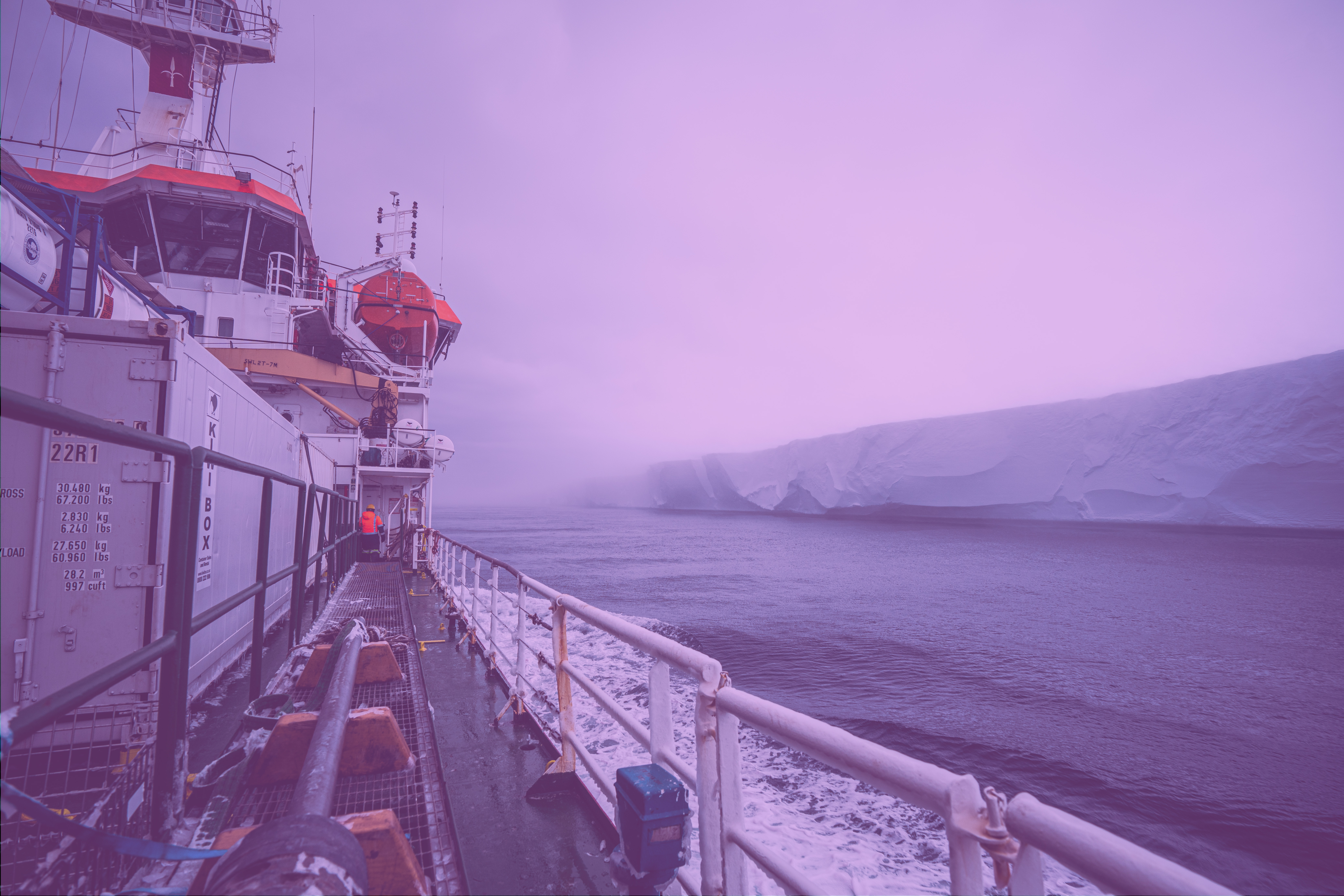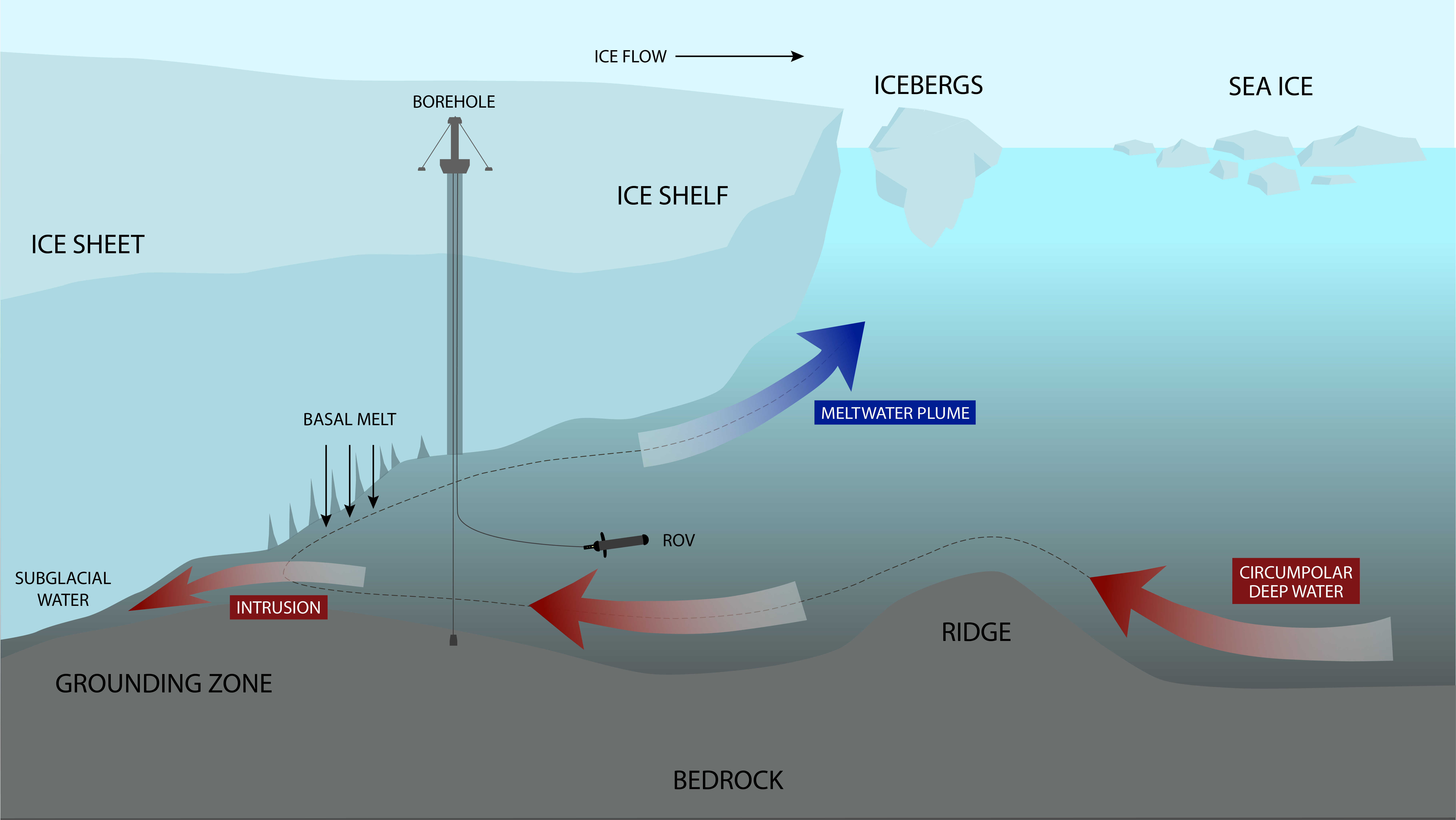
Ice mass loss: Antarctic ice sheets and shelves respond to climate change
Antarctic ice melt is a significant aspect of climate change that contributes to sea level rise and impacts regional and global climate patterns. The Antarctic Ice Sheet and ice shelves (floating on the ocean) are losing mass through a combination of ocean and atmospheric warming. When relatively warm ocean currents move under ice shelves, the ice melts from below. At the same time, warming air temperatures can increase surface melt, which can cause cracks to form and accelerate collapse. Simulation of past, present, and future change strengthens scientific understanding and improves predictions of ice sheet and climate behaviour.
This summary
This summary aims to inform policy makers and scientific peers about the research into ice mass loss conducted in the Ross Sea region by New Zealand’s Antarctic Science Platform (ASP).
This research synthesis:
- shares fundamental information about ice sheets and shelves in Antarctica
- highlights climate-related risks to ice environments in the Ross Sea region
- provides insights into the processes that influence ice mass loss and raise global sea level
- provides examples of how the ASP contributes to international science and modelling to understand past, present, and future change in Antarctica and the Southern Ocean.
Key points
- The Antarctic Ice Sheet is a large, continuous mass of ice that covers 98% of the Antarctic continent. It is losing on average 150 gigatonnes of ice annually to the surrounding ocean, contributing to global sea level rise.
- A range of Antarctic Ice Sheet model experiments produce similar meltwater contributions to sea level in the near-term (decades), while long-term outcomes (centuries) diverge significantly. The upper (still plausible) range of these projections highlights the importance of limiting warming now to reduce future sea level rise.
- Antarctic ice shelves, such as the Ross Ice Shelf, are floating extensions of the Antarctic Ice Sheet and play an important role in buttressing flow — preventing the ice on land from flowing more rapidly into the ocean. Monitoring and modelling of basal melt, calving and discharge are essential for understanding ice shelf dynamics and their impact on the stability of the grounded ice sheet.
- Crevasses play an important role in circulating seawater beneath the Ross Ice Shelf, potentially influencing their stability.
- Seasonal basal melt influences ice flow variability in some, but not all, Ross Ice Shelf regions. Sensitivity maps produced through ASP research offer important guidance on critical vulnerabilities and for future fieldwork and modelling.
Ice mass loss research

Our research is an important part of global understanding and call for action
Projecting the Antarctic Ice Sheet’s future under different emissions pathways
ASP researchers held leading roles for the Intergovernmental Panel on Climate Change (IPCC) Sixth Assessment Report, in particular the Chapters on Ocean, Cryosphere and Sea Level Change, and Water Cycle Changes. IPCC coordinating/lead authors are responsible for evaluating scientific literature and producing comprehensive reports on climate change, its impacts, and potential mitigation and adaptation strategies. This provides good visibility to the ASP team on future policy and research priorities, and how to help address them. It also provides useful connectivity of ASP research to help inform IPCC considerations.
ASP researchers have also contributed to the Ice Sheet Model Intercomparison Project for CMIP6 (ISMIP6). The project is a global effort to project how Greenland and Antarctic ice sheets will affect sea level rise under different emissions scenarios, informing the IPCC's Sixth Assessment Report. In updated simulations, the ISMIP6-Antarctica team identified that East Antarctica’s Totten and Moscow University glaciers are as vulnerable to ice loss as West Antarctica’s Thwaites and Pine Island glaciers. ASP researchers are also a part of the ISMIP6-2300 project, which models Antarctic ice sheet behaviour and sea level rise through to the year 2300, linked to different emissions scenarios and modelling uncertainties.
Collaborating with Our Changing Coast
The SWAIS2C team has strong connections with ‘New Zealand Sea Rise’ and ‘Our Changing Coast’ research programmes. This allows for the improved and evolving contributions from Antarctic ice sheets to help inform sea level rise impacts in New Zealand. This partnership directly connects ASP research to national coastal hazard guidance and coastal planning in communities across Aotearoa.
Definitions
Ice sheet: All ice that rests on bedrock, regardless of whether the bedrock is above or below sea level.
Ice shelf: Floating glacial ice that is an extension of the grounded ice sheet (ice is lighter than water so it floats in the ocean).
Marine ice sheet instability: A marine ice sheet is an ice sheet whose base lies below sea level. This means the ice is grounded on land that is submerged, making the ice particularly sensitive to retreat through ocean warming, unlike ice sheets that rest on land above sea level. A key feature of marine ice sheets is their grounding line, the boundary where the ice transitions from being grounded on land to floating as an ice shelf. The stability of a marine ice sheet is heavily influenced by the location and movement of this grounding line.
Basal melting: Warm, deep ocean currents flow beneath the floating ice shelves surrounding Antarctica. These currents melt the ice from below, a process called basal melting.
Grounding zone: The grounding zone in Antarctica refers to the area where the grounded ice sheet transitions to a floating ice shelf, typically over a few kilometres. This transition zone is crucial for understanding ice sheet stability, mass balance, and future projections of ice sheet behaviour.
Contact information
Richard Levy
Principal Scientist – Earth Sciences NZ
r.levy@gns.cri.nz
Dan Lowry
Adjunct Researcher, Te Herenga Waka—Victoria University
of Wellington
dan.lowry@vuw.ac.n
Selected References
Baldacchino et al. (2023). Modelling GNSS-observed seasonal velocity changes of the Ross Ice Shelf, Antarctica, using the Ice-sheet and sea level System Model (ISSM). EGUsphere. https://doi.org/10.5194/egusph...
Davison et al. (2023). Annual mass budget of Antarctic ice shelves from 1997 to 2021. Science Advances 9(43). https://doi.org/10.1126/sciadv...
Duncan et al. (2022). Climatic and tectonic drivers of late Oligocene Antarctic ice volume. Nature Geoscience 15(10). https://doi.org/10.1038/s41561...
Lawrence et al. (2023). Crevasse refreezing and signatures of retreat observed at Kamb Ice Stream grounding zone. Nature Geoscience 16(3). https://doi.org/10.1038/s41561...
Lau et al. (2023). Genomic evidence for West Antarctic Ice Sheet collapse during the Last Interglacial. Science 382(6677). https://doi.org/10.1126/scienc...
Levy et al. (2024). Melting ice and rising seas – connecting projected change in Antarctica's ice sheets to communities in Aotearoa New Zealand. Journal of the Royal Society of New Zealand 54(4). https://doi.org/10.1080/030367...
Marschalek et al. (2021). A large West Antarctic Ice Sheet explains early Neogene sea level amplitude. Nature 600. https://doi.org/10.1038/s41586...
Naish et al. (2024). The significance of interseismic vertical land movement at active tectonic margins for sea level rise projections. Earth's Future 11(6). https://doi.org/10.1029/2023EF...
Seroussi et al. (2023). Insights into the vulnerability of Antarctic glaciers from the ISMIP6 ice sheet model ensemble and associated uncertainty. The Cryosphere 17. https://doi.org/10.5194/tc-17-...
Stutz (2023). Inland thinning of Byrd Glacier, Antarctica, during Ross Ice Sheet retreat. Earth Surface Processes and Landforms. https://doi.org/10.1002/esp.57...
Venturelli et al. (2020). Mid-Holocene grounding line retreat and readvance at Whillans Ice Stream, West Antarctica. Geophysical Research Letters 47(24). https://doi.org/10.1029/2020GL...
Washam et al. (2023). Direct observations of melting, freezing, and ocean circulation in an ice shelf basal crevasse. Science Advances 9(43). https://doi.org/10.1126/sciadv...
Whiteford et al. (2022). Melting and refreezing in an ice shelf basal channel at the grounding line of the Kamb Ice Stream, West Antarctica. Journal of Geophysical Research: Earth Surface 127. https://doi.org/10.1029/2021JF...